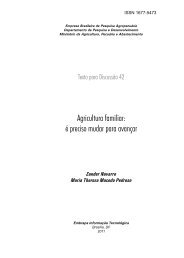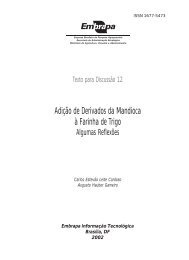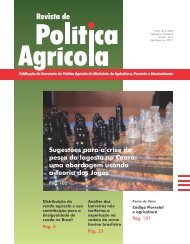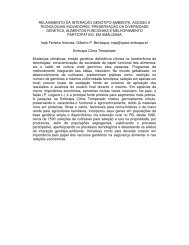Ministry of Agriculture, Livestock and Food Supply - Embrapa
Ministry of Agriculture, Livestock and Food Supply - Embrapa
Ministry of Agriculture, Livestock and Food Supply - Embrapa
You also want an ePaper? Increase the reach of your titles
YUMPU automatically turns print PDFs into web optimized ePapers that Google loves.
Table 8. OIB Evolution by energy source.<br />
Source<br />
Projections for Brazil<br />
The gross domestic supply (GDS) <strong>of</strong> energy in Brazil5 in 1999 was 183<br />
Mtep6 . It is estimated that the domestic supply <strong>of</strong> energy should reach 617 Mtep<br />
by 2020 (Table 7), equivalent to a 4.4% p.a. growth during the period 2000-2020.<br />
At the end <strong>of</strong> 1999 the measured petroleum reserves equaled a 20-year<br />
production, pointing to depletion by the 2020s. Eighty-eight percent <strong>of</strong> proven<br />
petroleum reserves <strong>and</strong> 65% <strong>of</strong> proven natural gas reserves are located at great<br />
ocean depths.<br />
It is foreseen in this scenario that petroleum <strong>and</strong> the energy derived from<br />
sugarcane should become less important, while natural gas would secure a<br />
relevant share <strong>of</strong> the 2020 Brazilian energy matrix (Table 8).<br />
Nevertheless, the predicted cost reductions in biomass energy production<br />
(Table 9) could alter this scenario, depending fundamentally on the evolution <strong>and</strong><br />
outcomes <strong>of</strong> technological research, development <strong>and</strong> innovation along the various<br />
agroenergy lines <strong>of</strong> action.<br />
Table 7. GDS projections in thermal equivalent values.<br />
Year<br />
Mtep<br />
2000<br />
260<br />
Petroleum<br />
Hydroelectric<br />
Natural gas<br />
Sugarcane<br />
Coal<br />
Uranium<br />
Other primary sources<br />
Firewood – charcoal<br />
2005<br />
300<br />
Source: CGEE – State-<strong>of</strong>-the-art <strong>and</strong> technology trends in energy.<br />
Source: CGEE – State-<strong>of</strong>-the-art <strong>and</strong> technology trends in energy.<br />
60<br />
2000 (%)<br />
47<br />
14<br />
5<br />
12<br />
7<br />
1<br />
2<br />
11<br />
2010<br />
2020 (%)<br />
5 The GDS considers domestic production, imports, exports, stock variation, <strong>and</strong> unused energy.<br />
6 Calculating the electric power by means <strong>of</strong> its caloric equivalent: 1 kWh = 860 kcal.<br />
396<br />
2020<br />
617<br />
42<br />
15<br />
16<br />
8<br />
8<br />
1<br />
3<br />
7












